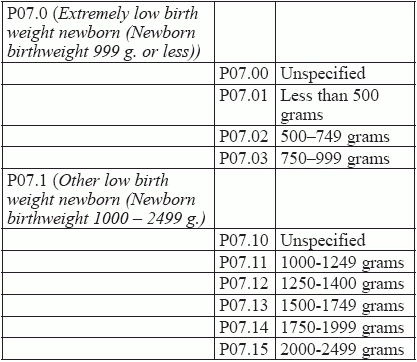Z Codes Key to Code Newborn Low Weight, Weight Loss

But P, R codes spell success for specific diagnoses. Weight loss among newborns after birth is a common occurrence. Most will surpass their birth weight after ten days, but not all. Bad news: As many as half of all newborns will not regain their initial weight up to ten days after delivery, according to a recent American Academy of Pediatrics (AAP) study (http://pediatrics.aappublications.org/content/138/6/e20162625). This creates several challenging ICD-10-CM scenarios that range from coding normal, healthy newborn growththrough to coding for more serious abnormal findings and disorders. Read on for great tips on codingweight loss or low-weight scenarios in newborns and infants. Start Newborn Coding with a Z Chapter 21 of the 2017 ICD-10-CM guidelines state that the birth of a child triggers the use of a status, or Z, code. The guidelines go on to state that these codes “may be primary or secondary”; however, they cannot be used as a substitute for CPT® procedure codes. “So,” as Donelle Holle, RN, President of Peds Coding, Inc, and a healthcare, coding, and reimbursement consultant in Fort Wayne, Indiana, points out, “if a physician sees a neonate on the initial day of birth and the baby is ‘healthy and normal,’ coding for the vaginal delivery of one baby will beZ38.00 (Single liveborn infant, delivered vaginally) with 99460 (Initial hospital or birthing center care, per day, for evaluation and management of normal newborn infant).” In addition to documenting births, you’ll use Z codes when documenting newborn, infant, or child health examination encounters. Z00.110 (Health examination for newborn under 8 days old), Z00.111 (Health examination for newborn 8 to 28 days old), and Z00.12 (Encounter for routine child examination … for child over 28 days old) are the codes you would use as part of the record for any weight issues (Z00.111 specifically includes weight check as a part of its descriptor). All the codes have the provision for using “an additional code for any abnormal findings,” which would include low birth weight or weight loss, per ICD-10-CM guidelines. Sixth digit alert: A sixth character should be appended to Z00.12 to report normal (9) or abnormal (1) findings. Again, you would need to use an additional code if you report Z00.121. Look to P07 for Low Birth Weight Newborns If the child is under 28 days old, the P07 series of ICD-10-CM is one of the first places you can find an appropriate code if the newborn is simply low weight. The following table provides a handy reference for those codes: Use These Codes for Abnormal Weight Loss If the newborn has lost weight abnormally, there are many ICD-10-CM codes that could then come into play. Mary I. Falbo, MBA, CPC, CEO of Millennium Healthcare Consulting, Inc., Lansdale, Pennsylvania, offers R63.4 (Abnormal weight loss) as an obvious choice. You might report this code in conjunction with P92.8 (Other feeding problems of newborn) or P96.89 (Other specified conditions originating in the perinatal period). However, “when using ICD-10 codes, you want to be as specific as possible,” Holle stresses. “Although there may be times when we have to use the unspecified codes, if there is another diagnosis code that can be used and is more specific, then that code should be used.” Other R series codes that could apply to an abnormal weight loss diagnosis include R63.3 (Feeding difficulties) or R62.51 (Failure to thrive [child]). Coding tip: Be sure to read the descriptors for these codes very closely, as their use will exclude the use of other similar codes. R62.51, for example, explicitly states that use of this code excludes use of P92.6 (Failure to thrive in newborn). And R63.3 excludes codes in the P92 series (Feeding problems of newborn) as well as F98.2 (Other feeding disorders of infancy and childhood) The P92 codes are another great place to find abnormal weight loss diagnoses. “Many of those can be used in this situation,” Holle explains, pointing to P92.2 (Slow feeding of newborn) and P92.5 (Neonatal difficulty in feeding at breast) as prime examples. Coding tip: Don’t forget to double-check the child’s age if your provider uses failure to thrive as the diagnosis for abnormal weight loss. If the infant is under 28 days, you would choose. P92.6 (Failure to thrive in newborn) as the most appropriate diagnosis. But if the child is over 28 days old, you should use R62.51 (Failure to thrive [child]). 

-min.webp)


